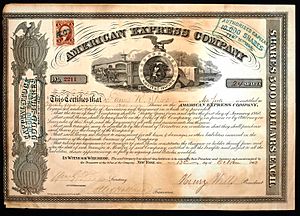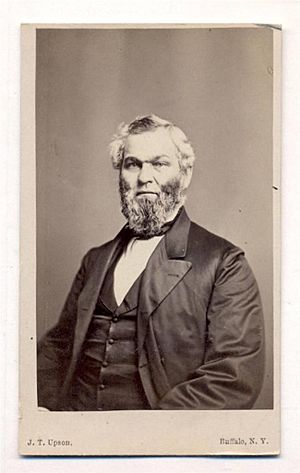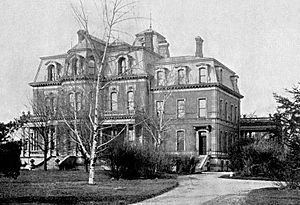William Fargo facts for kids
Quick facts for kids
William Fargo
|
|
|---|---|
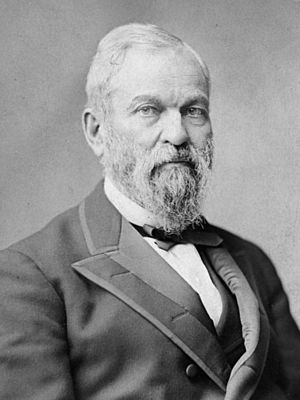 |
|
| 27th Mayor of Buffalo | |
| In office 1862–1866 |
|
| Preceded by | Franklin A. Alberger |
| Succeeded by | Chandler J. Wells |
| Personal details | |
| Born |
William George Fargo
May 20, 1818 Pompey, New York, U.S. |
| Died | August 3, 1881 (aged 63) Buffalo, New York, U.S. |
| Resting place | Forest Lawn Cemetery, Buffalo, New York |
| Political party | Democratic |
| Spouse | Anna Hurd Williams |
| Relations | J. C. Fargo (brother) |
| Children | 11 |
| Occupation | Banker, politician |
| Known for | Co-founder of American Express Company and Wells Fargo |
William George Fargo (May 20, 1818 – August 3, 1881) was an important American businessman. He helped start two well-known financial companies: American Express and Wells Fargo. He worked with his business partner, Henry Wells, to create these companies. William Fargo also served as the 27th Mayor of Buffalo from 1862 to 1866, during the American Civil War.
Contents
Early Life and Beginnings
William George Fargo was born in Pompey, New York on May 20, 1818. He was the oldest of twelve children. His parents were William C. Fargo and Stacy Chappel Strong. His younger brother, James Congdell Strong Fargo, later became president of American Express.
William's schooling was brief. He left school at age 13 to help his family. He started by carrying mail in his hometown of Pompey. His father had fought in the War of 1812.
In 1838, Fargo began working for grocery stores in Syracuse, New York. Later, he worked for a company that helped send goods. In 1841, he became a freight agent for a railroad, moving goods between Albany, New York and Buffalo, New York. By 1843, he was a resident agent in Buffalo, working for Livingston, Wells & Co.
Building Business Empires
American Express Company
On April 1, 1845, William Fargo, along with Henry Wells and Daniel Dunning, started a company called Western Express. This company moved goods from Buffalo, New York to places like Cincinnati, St. Louis, and Chicago. At that time, there were no railroads going west of Buffalo. So, Fargo used steamboats and wagons to transport items.
Later, Daniel Dunning left the company. In 1846, Henry Wells sold his part of the business. William A. Livingston became Fargo's new partner, and their company was called Livingston, Fargo & Company.
In 1850, three express companies, including Wells & Company and Livingston, Fargo & Company, joined together. They formed the American Express Company. Henry Wells became the President, and William Fargo became the Secretary.
In 1866, Henry Wells retired. Fargo was then elected President of the American Express Company. He led the company until he died in 1881. After his death, his brother, J. C. Fargo, took over as president.
Wells Fargo & Company
In 1852, Henry Wells and William Fargo started another company called Wells Fargo & Co.. This happened because other directors at American Express did not want to expand their business to California.
Wells Fargo & Co. was created to send goods and money between New York and San Francisco. They used a route through the Isthmus of Panama. The new company offered banking services, like buying gold and selling bank drafts. They also offered express services to quickly deliver gold and other valuable items.
The company opened its first office in San Francisco during the California Gold Rush. Soon, Wells Fargo opened offices in many new cities and mining camps in the West.
In 1861, Wells Fargo & Company bought and reorganized the Overland Mail Co. This company had been formed to carry mail for the United States.
Other Business Interests
Besides his express companies, William Fargo was involved in other businesses. He was a director and vice-president of the New York Central Railroad. He also served as a director for the Northern Pacific Railway and the Buffalo, New York and Philadelphia Railroad Company. He owned shares in several large manufacturing businesses in Buffalo.
Political Career
In 1861, William Fargo was elected mayor of Buffalo. He served two terms, from 1862 to 1866. Fargo was a member of the Democratic Party. He was against states leaving the Union. During the American Civil War, he supported the Union. He even paid part of the salaries for his employees who were drafted into the army.
Personal Life and Home
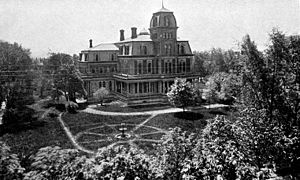
In 1840, William Fargo married Anna H. Williams. They had eight children together.
In 1868, when he was 50 years old, Fargo bought a large piece of land in Buffalo. Between 1868 and 1872, he built the Fargo Mansion. It was the biggest mansion in Buffalo. The house cost $600,000 to build and another $100,000 to furnish.
The mansion was huge, covering about 22,170 square feet. A historian described it as "the most elaborate and costly private mansion in the state," outside of New York City. It took up two city blocks. The house had a central tower that was five stories high. It was the first home in Buffalo to have an elevator. Some even said it had gold doorknobs!
William Fargo passed away on August 3, 1881, after being ill for several months. He was buried at Forest Lawn Cemetery, Buffalo.
Legacy
After William Fargo's wife, Anna, died in 1890, their two surviving children lived elsewhere. The Fargo Mansion stood empty for 10 years. It was too expensive to keep up, and no one wanted to buy it. So, in 1901, the mansion was taken down. The land was then divided into smaller lots for homes. The mansion and its grounds were only 30 years old when they were demolished.
Several places are named after William Fargo. These include Fargo Avenue in Buffalo, the Fargo Quadrangle at the University at Buffalo, and the city of Fargo, North Dakota.
The Fargo Estate Historic District was added to the National Register of Historic Places in 2016.
See also
 In Spanish: William Fargo para niños
In Spanish: William Fargo para niños


